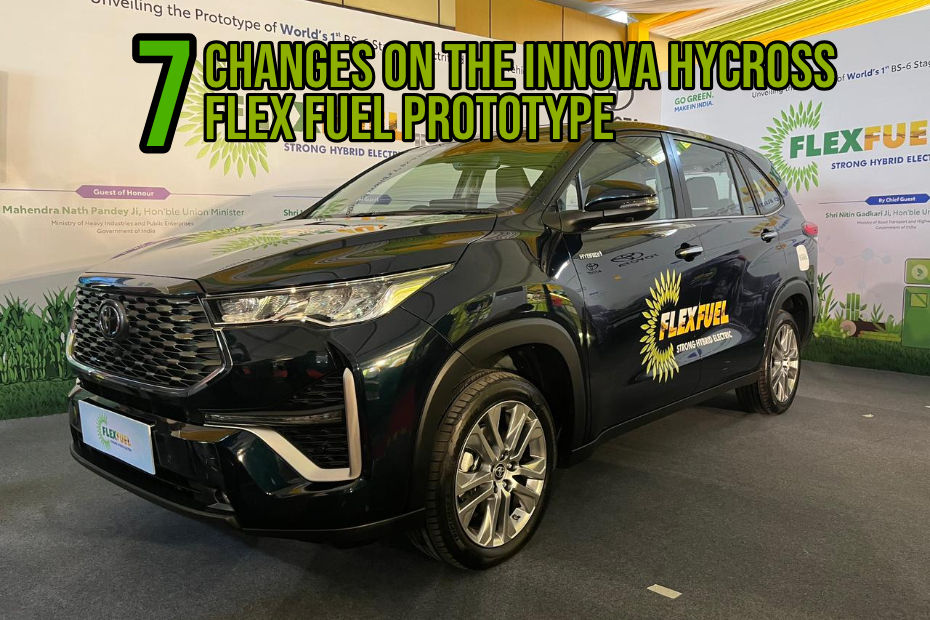Here Are The 7 Changes Made To Turn The Toyota Innova Hycross Strong Hybrid Into A Flex Fuel Model
Modified On Aug 30, 2023 12:16 PM By Tarun
- Write a comment
These were the necessary changes from the regular petrol engine to adapt to the different properties of a ethanol-rich fuel

Union Minister Nitin Gadkari recently revealed the Toyota Innova Hycross electrified flex fuel prototype, which can run on greener fuel with up to 85 percent ethanol blend. The prototype uses the Hycross’ 2-litre strong-hybrid petrol powertrain which allows the car to switch between fuel and electricity to propel itself.
However, to adapt to this high percentage of ethanol blending, Toyota had to make a number of changes to the locally-manufactured engine and related components. These are all the key changes done to make it compatible to the E85 fuel:
Motor Driven VVT
A normal gasoline-powered engine can start at temperatures lower than zero degrees. Since ethanol’s heating temperature is much higher, it will face issues with cold start and take more time to start up. So, changes have been made to the engine to eliminate an ethanol car’s cold start issues and will now function at temperatures as low as negative 15-degrees Celsius.

Improved Corrosion-Resistance Within The Engine
Since the chemical nature of ethanol is more acidic than petrol, combined with its higher water absorption, it puts the engine at a higher risk of corrosion. As such, the flex fuel prototype gets ethanol compatible spark plugs, valve and valve seats and piston rings, which will resist corrosion and improve the wear and tear. Essentially, any components directly in contact with the high-ethanol fuel have been treated for the same.
Also Read: Maruti Invicto vs Toyota Innova Hycross vs Kia Carens: Price Comparison
Three-Way Catalyst
A more advanced three-way catalyst is used on ethanol-powered cars, so as to reduce the emissions significantly. It is also because the combustion of ethanol produces different hydrocarbons, besides NoX and carbon emissions, than regular petrol. This way, it complies with the BS6 phase 2 compliance norms.

High Pressure Fuel Injectors
This is a significant change to the petrol-engine. Ethanol burns at a higher temperature than gasoline, and the engine needs more of it to burn to generate the performance needed. The Ethanol-powered Hycross employs high pressure fuel injectors (direct fuel injection) that not only provide the required flow rate, but also have been reinforced to the extra heat and be corrosion resistant.
Changes To The Fuel Tank
Anti oxidant materials and coating have been used to modify the fuel tank and fuel pipe of the Innova Hycross. This again has been done to keep corrosion and rusting at bay, ensuring a smoother fuel-flow over a long period of time.

Ethanol Sensor
A key addition over the regular Hycross in the flex fuel MPV is that it also gets an ethanol sensor, which measures the mix or concentration of ethanol in the fuel. The flex fuel sensor relays this information to the specialised ECU to electronically adjust other aspects of the engine. This is no different than how regular petrol models can detect the octane ratings of the fuel. Also, if you happen to top-up on a lower blend like E20 in case you’re not near an E85 pump, the system needs to be able to assess the current blend in your fuel tank to continue smooth operations of the engine.
Also Read: Upcoming Electric Cars In India
Changes To The ECU
The ECU (engine control unit) of the Hycross flex fuel determines the electronically controlled functions of the engine based on the percent of ethanol blend detected by the ethanol sensor and accordingly calibrates the settings. This ensures that the engine seamlessly works on different percentages of ethanol blend, ranging from E20 to E85, or even just petrol, which is the definition of a flex fuel vehicle.

The Innova Hycross electrified flex fuel is capable of running on electric power 60 percent of the time and on bio fuel for the rest. This makes it more economical, and more environment-friendly to run than a flex fuel car running on 100 percent ethanol.
However, it is still far away from production and several tests and calibrations need to be done before making it ready for Indian roads. By 2025, all the vehicles will be first E20 (ethanol 20 percent blend) compatible and Toyota Innova Hycross hybrid flex fuel prototype could be ready for production in another 3 to 4 years after.
Read More on : Toyota Innova Hycross Automatic
1 out of 1 found this helpful














